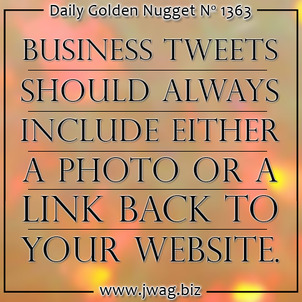
I've covered topics of Facebook, Pinterest, and Instagram so far in this Run-Up to the 2015 Holiday season. This is my 14th installment in this special Daily Golden Nugget series to help you boost your 2015 holiday sales.
If you're just joining in for the first time, then you should review the outline of this series I explained here. I'm continuing the deep concept of using a specific product or product line as the basis for a micro-marketing-campaign in which you devise a lot of content to promote that product, but you disperse that content evenly across all your media channels.
Today I'm concentrating on...
Don't fret if you don't understand Twitter; a lot of people don't. This social network invented the "micro-blogging" concept because every post is limited to 140 characters. Why 140 characters? That's because they allow their users to "tweet" from their phone; not just a smartphone, but any phone that can sent a text message. Prior to the smartphone app era, text messages were limited to 160 characters and a 140 character tweet fit nicely inside a text. In fact, Twitter was created as a text messaging service.
Sharing website addresses (URLs) in 140 characters is almost impossible, which is why all the website addresses you see on Twitter are shortened somehow. Tinyurl, Bitly, and Owly are all URL shortening services popularized by Twitter usage. There are hundreds of URL shortening services now.
Hashtags were invented on Twitter. Simply insert the pound or hash symbol (#) before any word and you instantly have a #hashtag. Twitter uses these hashtags for grouping, sorting, and searching through messages. Want to see photos of the most recent engagement rings posted to Twitter? Simply search #engagementring to see selfies, celebrity photos, and cross posts from Instagram.
Hashtag usage continues to grow and change every day. Post a photo with a hashtag to insert that photo into the results of anyone looking for it. Common jewelry hashtags include #jewelry, #ring, #engagementring, and #diamonds. Hashtags are also used for snarky commenting, irony or satire, and general-purpose comedy, oftentimes as a self-aware commentary of what was just posted before it.
Twitter for Personal Use
Non-business owners use Twitter as a platform for the commentary of the world around them. Some commentary is just a remark about their day; other times it's a comment about the sports game they are watching, or a TV show, news cast, or even a political debate.
In the past few years, Twitter has also facilitated immediate broadcast and notification of disasters. The Boston Marathon Bombing was reported by spectators through Twitter faster than the police and reporters could even react. The Virginia earthquake in August 2011 was also reported on Twitter 30 seconds before we felt it in my office in New Jersey. Celebrities have used it in lieu of a press conference, or as a way to publicly communicate to each other for the world to see and speculate on.
Twitter is the social network for up to the minute big news and personal commentary. But it's also a place for businesses.
Twitter for Business
All that personal activity is bound to attract businesses who want to insert their message into the massive number of tweets that occur every day. Appropriate use of hashtags easily allow your message to appear whenever someone searches for it. For that reason, you should investigate any hashtag you are thinking of using before you use it. You don't want to use a hashtag without knowing what it means; it could be inadvertently be offensive or controversial. Tonedeaf companies have stepped into messes on Twitter, not realizing what they are accidentally aligning themselves with.
Some have estimated the lifespan of a tweet to be only 8 minutes. There's so much noise on Twitter that your individual tweet is quickly buried by thousands of new tweets within a few minutes. Your followers will see your tweets if they look at your profile, but they probably won't see your tweet unless they happen to be using Twitter within 30 minutes of your tweet. This is exactly why it's okay for you to send out several tweets per day.
Tweeting several times a day is a good practice, but don't send the exact same tweet each time, instead, just rewrite it a little bit each time. Some experts say you can safely tweet once per hour while others recommend once every 8 hours. I find it beneficial for a retail jeweler to tweet about 5 times per day, which is almost every 5 hours.








